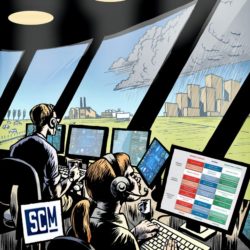A control tower starts with a solid foundation

How can you create maximum supply chain visibility? By laying a solid foundation for communication and collaboration with all partners in the digital supply chain ecosystem. Without that, according to Tesisquare, it is impossible to set up an effective control tower and get a grip on the supply chain. The Italian supply chain software vendor went into more detail during a recent Webinar Wednesday: “Tools to consolidate and analyse all the data are indispensable.”
By Marcel te Lindert
Russia’s attack on Ukraine is yet another disruption that is forcing companies to make their supply chains more robust and resilient. In parallel, a growing number of consumers are making grateful use of the benefits and opportunities of the ‘instant economy’. “These two developments are creating increasing complexity and unpredictability in today’s supply chains. Companies need to adopt new models to ensure business continuity and strengthen their supply chains. Real-time end-to-end visibility is an important part of that,” said Gianluca Giaccardi, Chief Product Officer of Tesisquare.
During this edition of Webinar Wednesday, Giaccardi explained that communication, collaboration and transparency are the three keys to achieving maximum supply chain visibility. “Those keys enable us to identify and address problems in the supply chain early on, including previously hidden problems further along the supply chain. This requires all the actors to be integrated in a digital supply chain ecosystem. The ability to integrate with other actors is a must nowadays.”
Data collection
Integration enables data to be collected from all parts of the ecosystem. That data can be supplemented with data about the risks faced by certain parts of the ecosystem. “This data enables supply chain decision-makers to react more quickly to current developments. This has to be combined with the data coming from tactical planning processes such as sales & operations planning (S&OP). Then, besides seeing what is happening in the supply chain right now, we can also predict what’s in store for us in the short to medium term.”
The digital supply chain ecosystem referred to by Tesisquare is very different from the traditional, linear supply chains of the past, which were static and predictable. For example, linear supply chains don’t allow for the circular processes that a rising number of companies are engaged in as part of their commitment to sustainability. “Nor do they allow for the continuing growth in the number of distribution channels. All those channels have to be managed simultaneously, and so too do the parties connected to those distribution channels,” stated Lorenzo Bollani, Head of Product Management at Tesisquare.
A living organism
Bollani’s explanation of digital ecosystems painted a picture of a living organism that is constantly renewing and evolving. The current disruptions are forcing many companies to look for multiple suppliers and to adapt their ecosystems accordingly. An ecosystem must allow them to operate flexibly and work with whichever suppliers they prefer. “That creates internal and external complexity as well as complex global, multimodal flows of goods, plus it makes the integration of ICT systems complex too.”
Tesisquare develops supply chain software that helps companies maximize their overview of – and visibility into – the ecosystem. Firstly, this is based on a solid communication layer. “In order to monitor the end-to-end supply chain, it’s necessary to communicate with chain partners by sending and receiving information. That communication is most effective when the partners speak the same language, such as by using EDI – but not everyone speaks this standard language. In that case, functionality is needed to set up private lines of communication with partners via APIs, for example, or to use information from other sources, such as the Internet of Things.”
Defining workflows
The second layer relates to the collaboration with chain partners, which requires not only a common language, but also a common set of master data. To facilitate collaboration, it is necessary to define the roles of all partners, as well as the workflows that connect them. Who should take which action, when? When are reminders or notifications sent? “Good collaboration also requires that parties are able to share documents with each other,” added Bollani.
The most important layer is the execution layer. At Tesisquare, that layer consists of various modules for controlling the various operational processes, such as managing suppliers, tracking and tracing products, executing transport orders and managing customer relationships. Tesisquare places a control tower on top of that. “The processes in the execution layer generate an enormous amount of data. Tools are indispensable for consolidating and analysing all that data to create an unambiguous picture of the end-to-end supply chain. That data can be supplemented with data from external sources about things like supply chain risks.”
Examples of control towers
Tesisquare outlined several examples of the use of control towers. For example, combining a map presenting external data about economic and geopolitical risks with a map showing all the actors in the ecosystem can help companies to assess the risks facing the various chain partners. Meanwhile, the use of predictive analytics and artificial intelligence makes it possible to estimate things like the arrival times of shipments. Bollani: “For example, we can test different scenarios to find the optimal balance between service level and costs so that decision-makers can choose and implement the best scenario. That’s what we mean by maximum visibility.”










